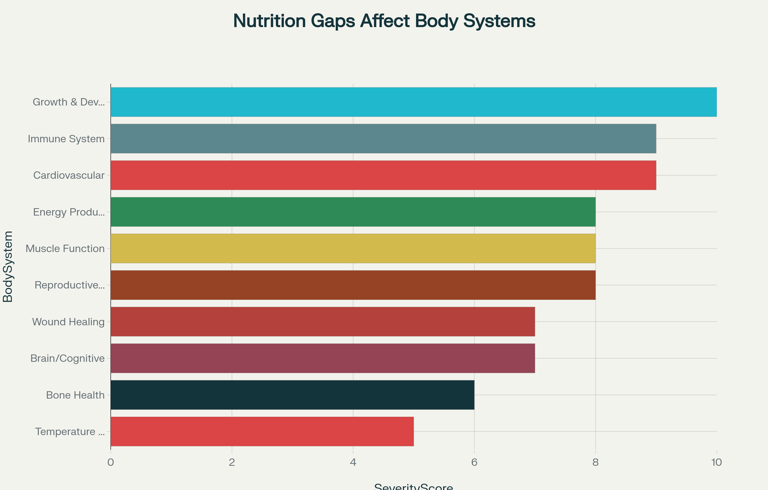The Hidden Health Crisis:
What Happens When You Don't Fill Your Nutrition Gap


What happens to your body when you don't fill your nutrition gap? Small investments in health can save you from big illness expenses
The Hidden Health Crisis: What Happens When You Don't Fill Your Nutrition Gap
When your body doesn't receive adequate nutrition, it triggers a cascade of health problems that affect every system in your body. This nutrition gap - the difference between what your body needs and what it actually receives - creates both immediate and long-term consequences that can be devastating to your health and expensive to treat.
The Comprehensive Impact on Your Body Systems
Malnutrition affects virtually every organ system in your body, creating a domino effect of health problems. The immune system bears one of the heaviest burdens, with reduced ability to fight infections becoming a primary concern. This vulnerability leads to more frequent illnesses, longer recovery times, and increased susceptibility to serious diseases.
Impact of Nutrition Gaps on Different Body Systems (Severity and Economic Impact)
Your muscle function deteriorates rapidly during malnutrition, with muscle mass declining before visible changes occur. This leads to weakness, increased fall risk, reduced work capacity, and difficulty performing daily activities. The cardiovascular system also suffers significantly, with reduced cardiac muscle mass leading to decreased cardiac output and compromised heart function.
Brain function and cognitive abilities decline substantially when nutrition gaps persist. Malnutrition causes apathy, depression, anxiety, and self-neglect, while also impairing memory, concentration, and learning capacity. In children, this translates to poor educational outcomes and reduced developmental potential.
The Hidden Hunger Phenomenon
Many people suffer from "hidden hunger" - a condition where you consume enough calories but lack essential vitamins and minerals. This form of malnutrition is particularly insidious because it can occur even in individuals who appear well-fed or are overweight.
Hidden hunger affects over 2 billion people worldwide, with deficiencies in iron, zinc, vitamin A, iodine, and B vitamins being most common. The consequences include anemia, blindness, cognitive impairments, poor birth outcomes, and increased mortality rates. Recent estimates reveal that 1 in 2 pre-school aged children and 2 of 3 women of reproductive age worldwide have at least one micronutrient deficiency.
Specific Consequences of Common Deficiencies
Iron deficiency, the most prevalent nutritional deficiency globally, leads to microcytic hypochromic anemia, characterized by fatigue, weakness, difficulty breathing, and decreased cold tolerance. It particularly affects development, behavior, and learning abilities in children.
Vitamin A deficiency causes night blindness, compromised immune function, and in severe cases, permanent blindness. Children with vitamin A deficiency show increased susceptibility to infections and reduced physical growth.
Vitamin D deficiency results in muscle weakness, bone pain, joint deformities, and mood changes. It significantly impacts calcium absorption, leading to rickets in children and osteomalacia in adults.
B vitamin deficiencies cause a range of problems from anemia and nerve damage (B12) to skin disorders and cognitive issues (various B vitamins). Vitamin B12 deficiency specifically can cause burning sensations in feet or tongue, balance problems, and memory issues.
The Staggering Economic Burden
The financial cost of untreated malnutrition is enormous. Globally, malnutrition costs up to $3.5 trillion annually - equivalent to $500 per person worldwide. This represents up to 5% of global income when including diet-related non-communicable diseases.
Global Economic Burden of Malnutrition by Population Impact
In specific regions, the burden is equally staggering:
Netherlands: €5.4 billion annually (3.4% of total healthcare costs)
United States: Over $147 billion annually in disease-associated malnutrition costs
Asia: $30 billion annually in additional hospital costs due to malnutrition
Cambodia: $266 million annually (1.7% of GDP)
Hospital malnutrition alone creates severe financial strain, with malnourished patients experiencing 31-34% higher costs than well-nourished patients with similar conditions. Severely malnourished patients have complication and mortality rates three to four times higher than normally nourished patients, with hospital stays up to 50% longer.
The Power of Small Nutrition Investments
The remarkable news is that small investments in nutrition yield extraordinary returns. Research consistently demonstrates that preventive nutrition interventions are among the most cost-effective health investments available.
Return on Investment for Nutrition Interventions - Small Investments, Big Health Savings
Key investment returns include:
Every $1 invested in nutrition yields $2.08-$18 in benefits
Malnutrition treatment provides $14.44 return per dollar over 5 years
Comprehensive nutrition programs deliver $5.8 return per dollar over 26 years
Digital weight management programs show 2.3:1 return on investment
These returns come from multiple sources: reduced healthcare costs, increased productivity, fewer missed work days, lower medication needs, and prevented chronic diseases. The cost-effectiveness of nutrition care in primary healthcare settings has been demonstrated across numerous studies, with interventions proving both more effective and economically beneficial than usual care.
Prevention: The Ultimate Investment
Prevention through proper nutrition is far more cost-effective than treating malnutrition-related diseases. Small investments in ensuring adequate nutrient intake can prevent:
Chronic diseases like diabetes, heart disease, and cancer
Cognitive decline and mental health issues
Immune system compromise leading to frequent infections
Bone health problems and increased fracture risk
Reproductive health complications
Early nutrition interventions are particularly powerful, with studies showing that interventions started within the first week of treatment or before illness develops yield the best outcomes. These early interventions result in reduced weight loss, improved treatment tolerance, fewer hospitalizations, and better survival rates.
The Long-term Perspective
The effects of nutrition gaps extend far beyond immediate health concerns. Adult earnings are reduced by 2.4% for every 1% loss in potential attained height due to childhood malnutrition. Malnutrition during critical periods like pregnancy and early childhood creates lifelong consequences including reduced cognitive capacity, lower educational achievement, and decreased earning potential.
Conversely, proper nutrition during the critical 1,000-day window from pregnancy to a child's second birthday can save lives, promote full development, and deliver greater economic prosperity throughout life. This demonstrates that nutrition investments are not just health interventions - they're investments in human capital and economic development.
The evidence is clear: failing to fill your nutrition gap creates a cascade of health problems that affect every aspect of your life, while small, consistent investments in proper nutrition can prevent massive healthcare expenses and dramatically improve your quality of life. The choice between prevention and treatment isn't just about health - it's about the most economically sound decision you can make for your future


